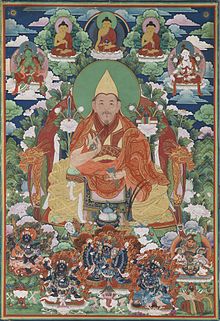Changkya Rölpé Dorjé
| Changkya Rölpé Dorjé | |
|---|---|
| ལྕང་སྐྱ་རོལ་པའི་རྡོ་རྗེ། | |
 |
|
| Religion | Buddhism |
| School | Tibetan |
| Lineage | Changkya Khutukhtu |
| Sect | Gelug |
| Other names | Changkya Rolpai Dorje, 章嘉·若白多杰 |
| Personal | |
| Born | 1717 |
| Died | 1786 |
| Religious career | |
| Reincarnation | Changkya Ngawang Losang Chöden |
Changkya Rölpé Dorjé (1717-1786) was a principal Buddhist teacher in the Qing court, a close associate of the Qianlong Emperor and an important intermediary between the imperial court and Inner Asia. He oversaw the translation of the Tibetan Buddhist canon into Mongolian and Manchurian.
Changkya Rölpé Dorjé was born on the 10th day of the fourth (Hor) month of the Fire-Bird year (1717) near Lanzhou in Gansu. At an early age he was recognized by the first Jamyang Zhepa as the incarnation of the previous Changkya Hotogtu of Gönlung monastery (佑宁寺) in Amdo (Qinghai), one of the four great Gelug monasteries of the North. At his investiture the Kangxi Emperor sent Kachen Shérap Dargyé as his representative.
In 1723, soon after the death of Kangxi and as the new ruler, Yongzheng (雍正, r. 1722-1735) was just establishing his authority, Mongol tribesmen claiming the succession of Gushri Khan, together with their Amdo Tibetan allies and supported by some factions within the monasteries, rose up against the Qing in the region of Kokonor. Yongzheng insisted on violent reprisals and in Amdo the Manchu army, destroyed villages and monasteries believed to have sided with the rebels including in 1724 Gönlung. However the emperor ordered that the seven-year-old Changkya incarnation not be harmed but brought to China as a "guest". At the Yongzheng Emperor's court, he was raised and educated to serve as an intermediary between the seat of Manchu power and the Buddhists of Amdo, Tibet and Mongolia. Rölpé Dorjé's monastic teachers included Zhangshu Kachen Shérap Dargyé; the second Thuken Hotogtu, Ngakwang Chökyi Gyatso and Atsé Chöjé Lozang Chödzin.
Changkya Rölpé Dorjé and his teachers realised that in order for the Gelugpa teachings to flourish in China and Manchuria they would need to be available in Chinese, Mongolian and Manchu and so he began the study of those languages. One of his fellow students was Prince Hungli who became his friend — and eventually the Qianlong Emperor (乾隆, r. 1735-1796).
He also took an interest in Chinese Buddhism and thought that their principle philosophical views had close similarities with those of the Vijñānavāda (विज्ञानवाद / སེམས་ཙམ་པ) school. He was also apparently the one who came up with the notion that Phadampa Sangye (the Indian founder of the Zhijé school in Tibet who also supposedly visited China) and Bodhidharma were the same person.
...
Wikipedia
